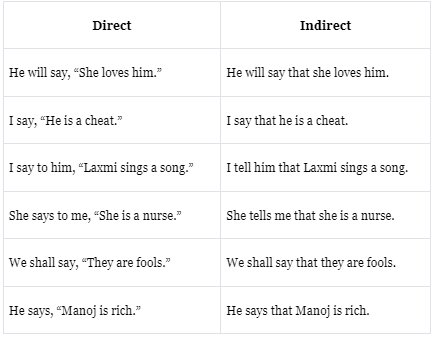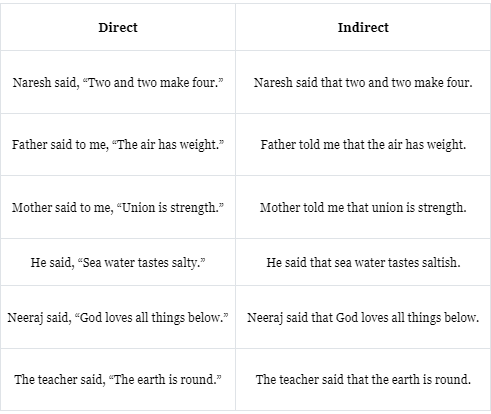Best Study Material for Class 7 Exam
Class 7 Exam > Class 7 Notes > English Grammar Class 7 > The Direct & Indirect Speech
The Direct & Indirect Speech | English Grammar Class 7 PDF Download
Direct Speech
- The exact words of the speaker are put within inverted commas. (” “).
- The first word of the R.S. begins with a capital letter.
- A comma is placed after the Reporting Verb to separate it from the second part of the sentence.
Indirect Speech
- The reported words are not placed within inverted commas.
- No comma is placed after “said”.
- The reported speech is introduced by the conjunction that/if/to/what/when, etc.
- The tense of the verb in the R.S. is changed from the Present to the Past.
Rules for changing direct speech into indirect speech
- R.V. say/says/will say/shall say/said is changed into tell/tells/will tell/shall tell/told or replied/informed or answered if it is followed by an object.
- The Conjunction that is used in place of the inverted commas.
- The first word of the reported speech does not begin with a capital letter except when it is a Proper Noun or pronoun I.
- The comma which separates the R.S. from the rest of the sentence is dropped.
- If the R.V. is in the Present or Future Tense, the Verb in the R.S. is not changed at all.

Exception to Rule
If the Reported Speech expresses some universal truth, factual truth, habitual fact, natural fact, historical fact, scientific fact, the tense of the verb in R.S. is not changed into the Past.

More to Know
- The Reporting Verb said or told are changed into asked/inquired/demanded etc.
- If the sentence begins with the helping verb or Modal Auxiliary then “if” or “whether” is used as conjunction.
- If a Positive Question in the R.S. has the helping verb do/does,do or does is dropped.
- The interrogative form changes into the Assertive form.
- The same word is used to introduce the R.S. if the Question begins with an Interrogative Pronoun or Adverb, such as what, which, whom and when, where, how and why etc.
The document The Direct & Indirect Speech | English Grammar Class 7 is a part of the Class 7 Course English Grammar Class 7.
All you need of Class 7 at this link: Class 7
|
39 videos|261 docs|61 tests
|
FAQs on The Direct & Indirect Speech - English Grammar Class 7
| 1. What is direct speech? |  |
| 2. What is indirect speech? |  |
Ans. Indirect speech, also known as reported speech, is used to report someone's speech or thoughts indirectly. It does not use the exact words spoken and often involves changes in pronouns, tenses, and word order.
| 3. What are the key differences between direct and indirect speech? |  |
Ans. The key differences between direct and indirect speech are:
- Direct speech uses the exact words spoken, while indirect speech reports the speech indirectly.
- Direct speech is enclosed within quotation marks, while indirect speech is not.
- Direct speech often requires changes in pronouns, tenses, and word order when converted to indirect speech.
| 4. How do you convert direct speech into indirect speech? |  |
Ans. To convert direct speech into indirect speech, you generally need to make the following changes:
- Change the pronouns and possessive adjectives to match the speaker and the reported speech.
- Change the tenses to reflect the time shift.
- Change the reporting verbs (e.g., say, tell) and the verb forms accordingly.
- Adjust the word order as necessary.
| 5. Can you give an example of converting direct speech into indirect speech? |  |
Ans. Certainly! Here's an example:
Direct speech: Mary said, "I am going to the park."
Indirect speech: Mary said that she was going to the park.
In this example, the pronoun "I" is changed to "she" to match the speaker, and the verb tense "am going" is changed to "was going" to reflect the time shift.
Related Searches




















